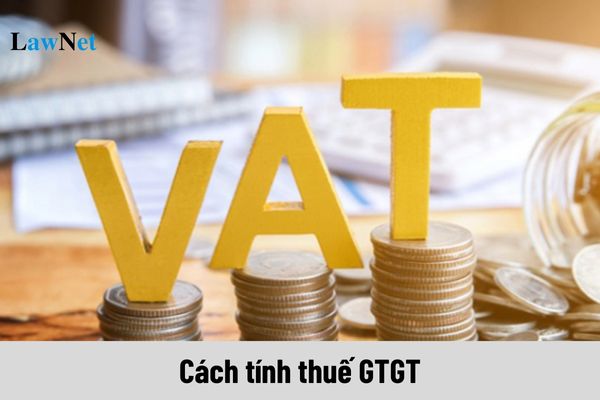How many methods are there to calculate VAT? What is the latest formula for calculating VAT in Vietnam?
How many methods are there to calculate VAT? What is the latest formula for calculating VAT in Vietnam?
According to the provisions of the Law on Value Added Tax 2008 and current documents, VAT is currently calculated using 2 methods:
- Tax credit method
- Direct calculation method on value added.
In principle, the general formula for calculating VAT is as follows:
VAT = Taxable price x VAT rate
However, to suit each subject applying VAT, the calculation will vary when applying the two methods of VAT calculation.

How many methods are there to calculate VAT? What is the latest formula for calculating VAT in Vietnam? (Image from the Internet)
What is the value-added tax credit method in Vietnam?
Based on Article 10 of the Law on Value Added Tax 2008 (amended by Clause 4, Article 1 of the Law on the Amendment of the Law on Value Added Tax 2013), it is stipulated as follows:
Tax Credit Method
1. The value-added tax credit method is specified as follows:
a) The VAT payable under the tax credit method is equal to the output VAT minus the input VAT credit;
b) The output VAT is the total VAT of goods and services sold as stated on the value-added invoice.
VAT on goods and services sold as stated on the value-added invoice is equal to the taxable sale price of goods and services multiplied by the VAT rate for those goods and services.
In case payment vouchers reflect prices including VAT, the output VAT is determined by the payment price minus the tax base determined under point k, clause 1, Article 7 of this Law;
c) The input VAT credit is equal to the total input VAT stated on value-added invoices for purchased goods and services, payments of VAT for imported goods, and meets conditions stipulated in Article 12 of this Law.
2. The tax credit method applies to business establishments that fully implement accounting policies, invoices, and documents as per legal regulations regarding accounting, invoices, and documents, including:
a) Business establishments with annual revenue from the sale of goods and provision of services of one billion VND or more, excluding households and individuals conducting business;
b) Business establishments that voluntarily apply for the tax credit method, excluding households and individuals conducting business.
3. The Government of Vietnam provides detailed regulations for this Article.
The value-added tax credit method is as follows:
- The VAT payable under the tax credit method is equal to the output VAT minus the input VAT credit;
- The output VAT is the total VAT of goods and services sold as recorded on the value-added invoice.
VAT on goods and services sold as recorded on the value-added invoice is calculated based on the taxable price of goods and services sold multiplied by the VAT rate applicable to those goods and services.
In cases where payment vouchers include prices with VAT, the output VAT is determined by the payment price minus the taxable base determined according to point k, clause 1, Article 7 of the Law on Value Added Tax 2008;
- The input VAT credit is equal to the total input VAT as stated on value-added invoices for purchased goods and services, payments of VAT for imported goods, and complies with the conditions set forth in Article 12 of the Law on Value Added Tax 2008.
Note: The tax credit method applies to business establishments that fully implement accounting policies, invoices, and documentation as per legal regulations regarding accounting, invoices, and documents, which include:
- Business establishments with annual revenue from selling goods and providing services of one billion VND or more, excluding business households and individuals;
- Business establishments that voluntarily register to apply the tax credit method, excluding business households and individuals.
What is the method of calculation of tax based directly on added value in Vietnam?
Based on Article 11 of the Law on Value Added Tax 2008 (amended by Clause 5, Article 1 of the Law on the Amendment of the Law on Value Added Tax 2013):
- The VAT payable under the direct method on value added is calculated as the value added multiplied by the VAT rate applicable to trading activities, gold, silver, and precious stones processing.
- The value added of gold, silver, and precious stones is determined by the selling price minus the purchasing price of the respective gold, silver, and precious stones.
To be specific, the VAT payable under the direct method on value added is determined by the percentage multiplied by the revenue applicable as follows:
Regarding applicable entities:
- Enterprises, cooperatives with annual revenue below the one billion VND threshold, except cases registered for the tax credit method as stipulated in Clause 2, Article 10 of this Law;
- Households and individuals engaged in business;
- Foreign organizations and individuals conducting business without a permanent establishment in Vietnam but generating revenue in Vietnam not fully implementing accounting policies, invoices, and documentation, excluding foreign organizations and individuals supplying goods and services for exploration, drilling, development, and extraction of oil and gas subject to the tax credit method and paid by the Vietnam side;
- Other economic organizations, except when voluntarily registered to pay tax under the tax credit method as stipulated in Clause 2, Article 10 of this Law;
The percentage for calculating VAT is stipulated as follows:
- Distribution, supply of goods: 1%;
- Services, construction without supply of materials: 5%;
- Production, transportation, services associated with goods, construction with supply of materials: 3%;
- Other business activities: 2%

